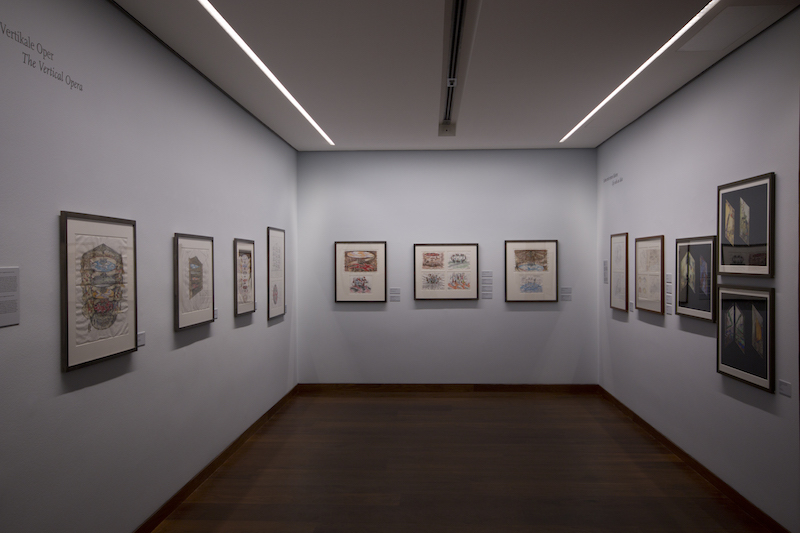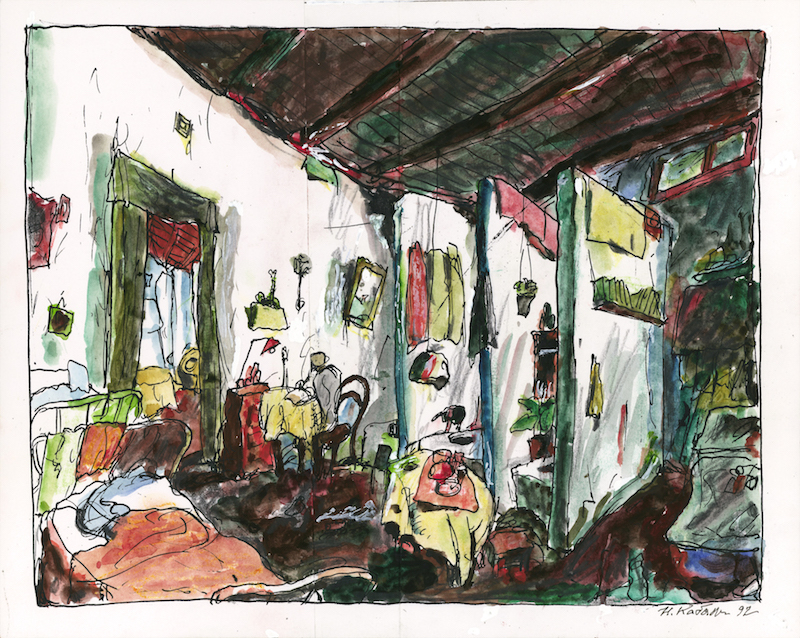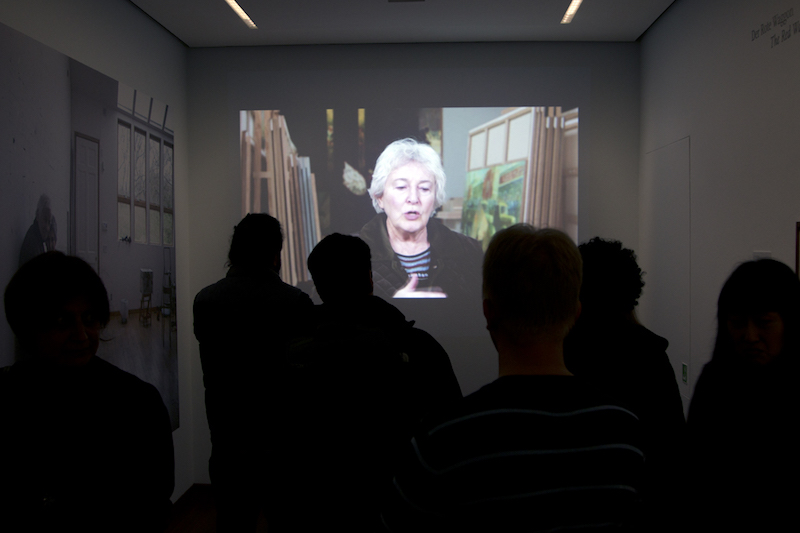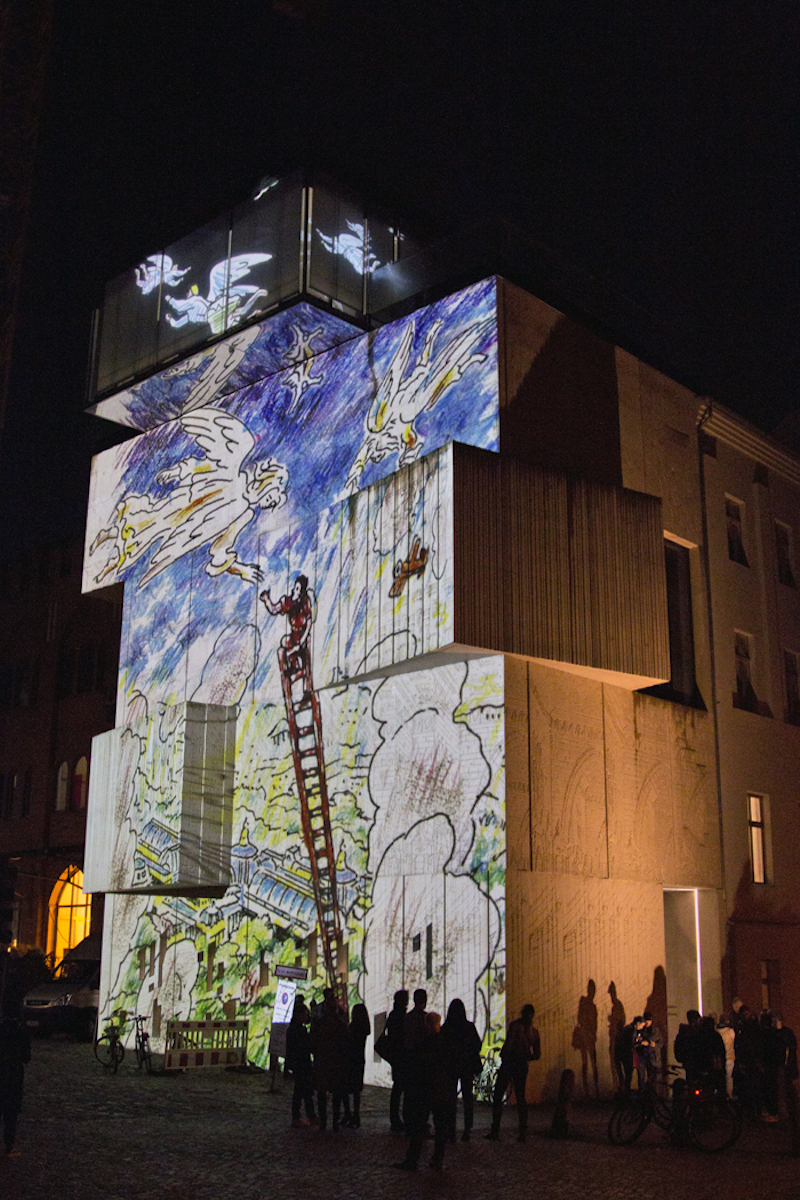Interview by Alison Hugill // Oct. 29, 2019
The Tchoban Foundation Museum for Architectural Drawing recently opened the exhibition ‘In the Making: Ilya & Emilia Kabakov. From Drawing to Installation,’ which celebrates the conceptual artist duo’s work on paper. The exhibition comprises sketches and colourful drawings of the Kabakov’s famous “total” installations.
Together with the curator of the exhibition, Esenija Bannan, Ilya and Emilia Kabakov gave us an insight into the concepts and process behind their impressive body of work.

‘In the Making: Ilya and Emilia Kabakov. From Drawing to Installation,’ installation view at Tchoban Foundation Museum for Architectural Drawing // Photo by Greg Bannan, courtesy of the Tchoban Foundation
Alison Hugill: Can you tell us about the process for creating your installations and where the paper form (drawings, sketches such as the ones on display in Berlin) fits into your practice? How is the direct translation of dreams and visions to paper different from a simple sketch of a work?
Ilya Kabakov: Many artists create multiple sketches before they start working on a painting, perhaps even complete a version of the painting with their pre-sketched idea. Installation is a three dimensional and very complicated work: it must be designed and built and often relies on drawings demonstrating proportions, scale and various perspectives. The works on paper become a helpful tool in our working process and, at the same time, document our creative process.
AH: There seems to be a clear connection between Ilya’s graphic illustration style (his former work as a children’s book illustrator) and the sense of narrative that each work encompasses; as though we are witnessing a story-book and its many characters come to life. What role does storytelling play in your practice?
Emilia Kabakov: Storytelling takes a central role in our art: whether they are children’s books that Ilya illustrated, or the many conceptual paintings he created, or drawings. Of course, this is also the case in our 200 installations, sculptures and public projects we did together. Storytelling makes people think and contemplate and it becomes not only about an image but about the content of the painting or installation. But narrative is what makes art work interactive. In a way, it is this interactive work that we are trying to implement into every artwork we create.

Ilya & Emilia Kabakov: ‘The Toilet’, 1992 // Courtesy of Ilya & Emilia Kabakov private archive
AH: Can you tell us a bit about your installation ‘The Toilet’ (1992) and what impact it had when presented next to the Friedricanium in Kassel as part of Documenta IX?
IK: This installation was discussed, written about and published numerous times and is a metaphor for life. It was a metaphor for life then and now we can say it is how we would describe life in many countries all around the world: yes, our country is ‘The Toilet.’ But even in a toilet we can and are living very comfortably, enjoying our small and secure space.
Of course, at the time of Documenta IX, many Russians took this work as an offence and for many years we had to dodge the tearful accusations from Russians: “why did you depict us as living in the toilet? We don’t live in a toilet.” And no matter how many times we tried to explain that this is not about Russia, it’s a metaphor of life in general, nothing helped. There was, actually, not even one object from Russia in that installation. We bought everything in Amsterdam at a Sunday flea market and brought it to Kassel.
BAL: Why is it important for you to convey aspects of your childhood and youth in the USSR in your work? As you are based in America, do you still have a connection to your homeland today or is it mostly accessed through memory?
EK: We never transferred anything personal into our work. Ilya spent 54 years in a certain cultural surrounding and, of course, his work is based on Russian culture, which is natural. Our work is always about human conditions, fears, hopes and, most importantly, dreams. We try to create an utopia, ideas of paradise, imaginary cities, angels and that is why it is universally accepted and understood. Of course, it is important that all of our works are using the universal language of art.

‘In the Making: Ilya & Emilia Kabakov. From Drawing to Installation’ Opening at Tchoban Foundation Museum for Architectural Drawing, 17.10.2019 // Photo by Greg Bannan, courtesy of the Tchoban Foundation
AH: The “total” installations have been likened to architecture. What is the relationship, for you, between art and architecture? And, as a curator, Esenija, how have you used the architecture of the museum in the display of the Kabakov’s works, especially the light installation?
EK: We did many architectural projects (see ‘Monument to The City of Bordeaux’ or ‘Monument to the Emigrants from Europe to America’). We can call them installations, but they are in fact architectural projects. Architectural projects and installations are spatial practices and it is very comfortable (at least for us) to move between both genres; to connect them and to include architectural elements in one work. Nothing is mutually exclusive. You can use paintings and music and voices and light in installation. And you can do the same with architectural projects.
Esenija Bannan: The light installation of the drawing ‘How to Meet an Angel’ was inspired by the drawing for the sculpture of the same title, which I saw at the Gutspark Böckel in Rödinghausen. To me, the silhouette of the museum and its glassed top complimented the figure climbing the wooden construction to meet the angel(s), which are flying on the glassed top and are visible from far away. Angels are important figures in the Kabakovs’ work and, by drawing this encounter with light on the museum’s façade, covered with fragments of architectural drawings, the connection between drawing and installation was accentuated.

Ilya & Emilia Kabakov: ‘How to Meet an Angel’, light installation at Tchoban Foundation Museum for Architectural Drawing // Photo by Greg Bannan, courtesy of the Tchoban Foundation
AH: How is it, as a curator, to show the Kabakov’s drawings independently from their associated installation, as they are presented in the current exhibition at the Museum for Architectural Drawing in Berlin?
EB: We wanted to present the sketches and watercolour drawings of the Kabakov’s famous installations as architectural drawings. Installation artists and architects both work with space and Ilya Kabakov often deploys traditional techniques of architectural drawing, which he transposes onto fantastical structures. Ilya and Emilia create the concept for an installation together and Ilya transfers their ideas onto paper. The works on paper are accompanied by photographs and project description of realized installations and a studio visit with Emilia talking about a few of their projects, including video images of the installations, which adds to the oeuvre of the artist duo. It was important to me to invite the visitor to immerse themselves in the cosmos of the artist couple and experience their well-known installations in a completely different way: on paper.
Exhibition Info
TCHOBAN FOUNDATION. MUSEUM FOR ARCHITECTURAL DRAWING
‘In the Making: Ilya & Emilia Kabakov. From Drawing to Installation’
Exhibition: Oct. 17, 2019 – Feb. 23, 2020
Christinenstraße 18a, 10119 Berlin, click here for map

























